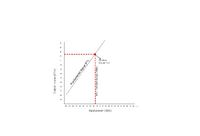robismyname
Full Member level 6
- Joined
- Jan 17, 2008
- Messages
- 390
- Helped
- 11
- Reputation
- 22
- Reaction score
- 9
- Trophy points
- 1,298
- Location
- Central Florida
- Activity points
- 4,603
Having a time tough understanding IIP3 (Third Order Intercept Point). I am loking at a radio chip made by Serenza/RFMD that has a IIP3 rating of -15dBm. Does this mean that my input signal to the LNA will be equal to the intermod signal at -15dBm?
